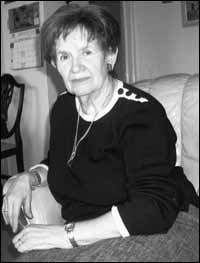| AUSCHWITZ - THE WORLD REMEMBERS From Auschwitz to the Queen in 60 years | |
Rebuilding her shattered life after Auschwitz was just as challenging as surviving the horrors of the extermination camp itself. Hungarian-born Rachel, now lives comfortably in Broughton Park surrounded by pictures of her four sons, their wives, grandchildren and great-grandchildren. But the trauma of the war and its aftermath still bubbles beneath the surface. Speaking for the first time in public about her experiences, Rachel said: "It was one thing being liberated, but what do you do after? Where do you go? How do you find your feet when you have nobody in the world to turn to?" Rachel was born in Debrecen, which had 350 Jewish families in the city, and she attended a Jewish school. Her father was a feather merchant. Although Jews and Christians lived side by side, antisemitism was endemic in the town. Rachel grew up in a climate where Jews were verbally and physically abused on a regular basis. The turning point in Debrecen was Pesach 1944, when Hungarian police rounded up all the Jews in the city and the surrounding county and incarcerated them in a ghetto. After four weeks, the family was packed into cattle trucks and sent to Auschwitz. Rachel said: "We didn't know if it was day or night. I lived in cloud-cuckooland and didn't want to face what was happening." Rachel never saw her parents after the first "selection". Her sister, Chaya, survived and eventually settled in Israel. She had aunts and an uncle with very large families, but more than 30 of her first cousins and their parents perished in the Holocaust. The infamous Auschwitz doctor, Mengele chose Rachel for work rather than death. She was not destined to the fate of the "useless eaters". The 16-year-old was sent to Plaszow concentration camp outside Krakow to repair German army uniforms in a workshop. She recalled: "It was a terrible two months. We had to shlep heavy things around the factory and were fed a subsistence diet of thin soup and a little bread." Plaszow was where Oscar Schindler's enamel factory was situated. It is depicted in the Stephen Spielberg's film Schindler's List. She was sent back to Auschwitz to endure another selection and was given her tattoo - the spidery blue numerals are still visible on her arm. At the selections, Rachel avoided Mengele's gaze and just looked into middle distance. "I was like a robot", she said. For three months Rachel was crammed into a barracks in Auschwitz with hundreds of women. There was no work, but three or four times a day the women had to line up in the garden for selections for the gas chambers. She was again selected for work and was sent to an ammunition factory near Dresden. She said: "I never experienced any acts of kindness from the Polish Kapos in Auschwitz or from the German guards." When she was finally liberated by the Russians, life was no easier. She said: "Two Jewish Russian soldiers warned us that the Russian soldiers only wanted to rape us, even though we were only skin and bone." Rachel and her sister, Chaya, jumped on top of any transport to find their way back home to see if anyone survived. Sadly, she recalled: "There was nothing left in Debrecen. All the Jewish houses had been taken over." At this stage Rachel had contracted TB and Chaya took her to the sanatorium in the town. Deprived of her family and penniless, Rachel spent five years after the war alone and sick in sanatoria in Hungary and Switzerland. It must have seemed to Rachel that the world did not care about the plight or the future of the Holocaust survivor. She recalled being angered by articles in the Israeli press, since rescinded, criticising Jews for being passive victims of the Nazis. "They did not understand the dehumanisation of Jews. And what could women and children do?" she argued. She met her husband, Mayer, a Romanian survivor while they were being treated for TB in Switzerland. They made it to England in the early 1950s to prepare for emigration to Israel at a camp in Essex. They settled in Manchester in 1954 where Rachel found her niche. Her late husband Mayer worked for the Shechita Board during the day and trained as an accountant in the evenings. They were "adopted" by Jack and Marian Lopian who found Mayer a job and introduced Rachel to Mizrachi. Rachel recalled: "It was a long fight to be accepted. People did not realise what we had been through." Had it not been for the support of her sister, Rachel admitted she would not have made it.
|
 Rachel Kahan
Rachel Kahan